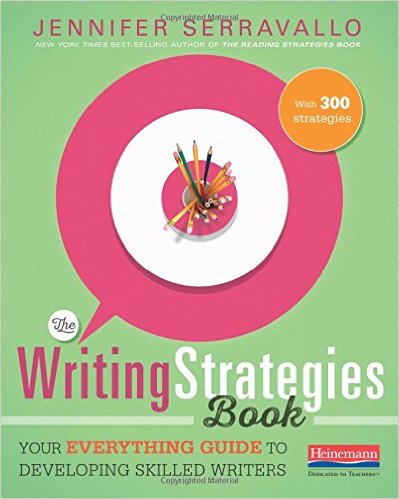Writing is a complex task. Even the best writers have difficulty putting their thoughts in words or build the world in words that they imagine or construct an argument that convinces the reader. The Writing Strategies Book talks about strategies that work toward specific goals. The book is aimed at school teachers who teach from emergent to K-8 grades and gives them resources to help their students learn the basics from planning a message to putting it down in words.
Jennifer Serravallo is literacy consultant and frequent speaker at state and national conferences. Jen worked for eight years as a staff developer and national consultant at the Teachers College Reading and Writing Project at Columbia University. In this capacity, she helped urban, suburban, and rural schools implement exceptional literacy instruction through reading and writing workshops. Jen holds a BA from Vassar College and an MA from Teachers College, where she has also taught graduate and undergraduate classes on urban education reform and children’s literature.
Title The Writing Strategies Book: Your Everything Guide to Developing Skilled Writers
Length: 424 pages
Author: Jennifer Serravallo
Publisher: Heinemann Educ Books, January 27, 2017
ISBN: 032507822X, 9780325078229
The Writing Strategies Book Review
Composing and writing even the simplest of messages involves many steps. An emerging writer can be stuck in each of this stages. Our young writer may be stuck at imagining the scene for a story, she might not be able to focus on writing, or be stuck because she is unable to spell the word. The author takes these problems that are a common thread across multiple assignments whether it is a Paper, Essay, or a Story and classifies them as goals.
Each of these goals become a chapter in the book. Now there may be multiple problems that stop your students from reaching their goals. The chapter looks at each of these problems and shows you what you can do in your classrooms to help your students solve these problems and reach their goals. For example, the first chapter goes straight to the root and discusses strategies that can help Primary students think in pictures and compose the message with pictures. The aim here is to make them understand that what they draw communicates a message. She shows how adding details to these pictures can help the young writer add rich text to their story.
From this point on The Writing Strategies Book touches each aspect of writing and discusses strategies for that particular goal. Chapter 5 talks about teaching Structure to students. A picture can be full of details, but it does not necessarily depict flow of information. A writing piece has to clearly communicate the beginning, the core, and the end. Here the author shares strategies that help students give their writing piece a three part structure. She covers structure for both Fiction and Non-Fiction. While the Fiction part focuses on building tension in the story or adding more detail (K-3 and above) the Non-Fiction part focuses on things like reasoning and organizing facts. The author discusses different strategies and also marks them with grade levels to let the reader know which grade is it suitable for. She then dives into these strategies and gives teachers with one-page summary that gives them tools to teach that strategy to their students.
The Writing Strategies Book assimilates useful information from leading books on writing in one place and gives teachers a resource that they can carry to their classrooms and help students deal with common problems that span multiple writing tasks.
Interview with Jennifer Seravallo
Jennifer Servallo on How to Conduct a Strategy Lesson
https://www.youtube.com/watch?v=XUdCUtHCKRI
